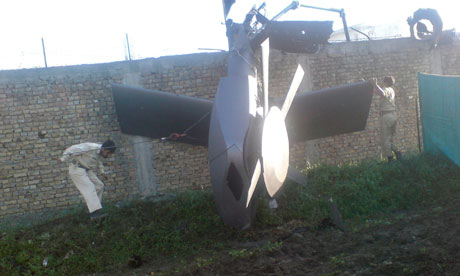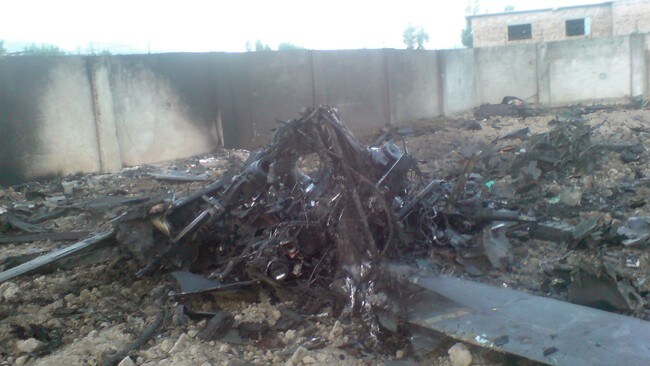Glojo wrote,
How long do we want the list of US military equipment having 'technical' issues that have caused them to crash or be destroyed?? My befuddled memory tells me that the last case of a 'technical' issue comparable to this was the helicopter that 'could not take off' after it developed 'technical' issues in the compound at the home of Bin Laden. Before that I can recall an Apache aircraft that was allegedly shot down over Iraq by a very old farmer with an antiquated rifle. The US claimed the thing had been forced to land because of 'technical' issues and the aircraft had subsequently been destroyed by an F-15E. The problem with that claim was that those of us with satellite TV saw this same helicopter on the back of a low loader being driven into an embassy compound in Baghdad!!
You do seem a bit 'befuddled'!
The helo at the Bin Laden compound came down over the compound. It couldn't take off due to the fact that it clipped the wall resulting in the tail shearing off. The tail ended up on the outside of the compound wall with the rest coming down inside the compound. The major part of the wreckage was destroyed in place but the tail on the other side remained intact.

The Pakistanis attempted to shroud the tail section on the outside of the compound.

The main portion of the helicopter was destroyed in place after the mission was complete.

Reference the US Army AH-64 Apache in Iraq. It was serial 99-5135 and later destroyed by US airstrike.
Apache down: the hunt for a sensitive US copter / The Christian Science Monitor - CSMonitor.com
"We directed an aircraft to the site, but when it got there, there were too many clouds," says US Army Lt. Col. Eric Nelson, air-operations officer for V Corps. "The pilot could see the helicopter [on the ground between the clouds], but he couldn't get a good lock on it to shoot it."
So recovery officials changed plans. They decided instead to use long-range artillery fire. But the crash site was close to US troops, and it took some time to clear the artillery barrage with commanders in the area.
By then, however, the Iraqis had loaded the helicopter onto a transport truck. For two days, US officials lost track of the Longbow.
At this point of the story, military officials choose their words very carefully. "Someone saw it and reported it," is all they will say. But it is no secret that a significant number of Special Forces troops were working behind enemy lines.
The Iraqis had transported the helicopter to a gully near what then was the Saddam International Airport. They covered it with camouflage tenting.
"Once we located it, we put an Air Force jet on it, and this time he destroyed it," says Colonel Nelson, who also answers to the call sign "Evil-6." "You want it blown apart. We didn't want to disable it. We wanted to totally destroy it so its parts couldn't be exploited."
The pilot dropped a 1,000-pound bomb.
About a week later, the 3rd Infantry Division pushed through the area, capturing the airport. A special detail was sent to recover whatever was left of the Apache.
Today, it is barely recognizable as a helicopter - a twisted hulk of green and black metal about the size of a small dump truck. The blades are doubled over and shattered. The only recognizable piece of equipment is the protective Kevlar shield that supports the pilot's seat. The seat itself is gone.
The wreckage is awaiting transport to American salvage specialists in Kuwait. "We don't leave our combat junk out on the battlefield," Nelson says. "The Iraqis won't have to clean up after us."
The Apache was one of 31 sent on a deep-attack mission to hit element of the Republican Medina Division near the city of Karbala. They were met with intense anti-aircraft fire and the crew of serial 99-5135 was forced to make an emergency landing. Chief Warrant Officer Ronald D. Young and Chief Warrant Officer David S. Williams were captured and later rescued.
The Iraqi Farmer, Ali Abid Minqash, featured by the Iraq Ministry of Information in the propaganda footage later gave an interview.
Minqash told the paper that he had come across the aircraft in his field early one morning.
"I didn't shoot down an Apache or anything else. All that happened was that I went to the field, as I usually do early in the morning, and was surprised to find some bodies on the ground.
"I began to rub my eyes to make sure that what I was seeing was true or whether I was imagining it," he said.
"When I realised that it was really true, I was overcome by fear and rushed to the nearest government post to inform them that there was a plane in my field.
"A large number of [Baath] party members and security men came with me to investigate. They told me that it was an American Apache aircraft and made me stay with them until someone who they said was a senior official arrived. I didn't know who he was.
"They asked me to say what you have heard on the TV satellite channels - that I shot down the plane with an old gun, a Brno."
BBC NEWS | Middle East | The 'Apache' farmer's tale
The Iraqi propaganda machine tried to use edited footage to claim another Apache captured later in the conflict.
From a recount of the mission.
As he pulled the trigger to lay down suppressive fire, Ron suddenly realized their problem was even worse. He had a total malfunction of his weapons systems. No chain gun, no rockets, and in the midst of the biggest firefight imaginable. At that point, the battle became very real. People were shooting at the helicopters from every direction. Feeling like a sitting duck, Dave and Ron flew big circles trying to evade enemy fire. Although Dave could still shoot from the back seat, Ron could do little more than provide an extra pair of eyes. It only got worse.
From the frantic radio traffic, it became obvious that Ron's helicopter had gotten separated from the rest of Charlie Company. They had rallied to the south at Checkpoint 17. Ron and Dave were alone at Checkpoint 19. Large red 14mm rounds streaked by the canopy and Ron became aware of the plink, plink sounds of random bullets scoring hits on their Apache. In desperation, Dave turned to the south to attempt a retreat from the area. Instantly, the two men heard an explosion and felt a violent shudder all through the airframe. The Apache had taken a direct hit in one of its two engines.
With the loss of an engine, the chopper could still fly, but only at a greatly reduced speed. More plinks were heard and smoke began to fill the cockpit. The controls went sloppy and the Up Front Display screen started scrolling a continuous stream of warning messages.
"Rotor low," warned the automatic voice annunciation system, indicating that rotor rpms were dropping. The helicopter was going down. In twenty seconds, the chopper impacted the terrain, tail first.
Dave had taken a shrapnel hit in the foot, but the two men were otherwise unhurt in the crash. It seemed to be their only piece of good luck. In seconds, Ron and Dave bolted from the aircraft and sprinted away from the crash site. A ditch afforded them some temporary protection so they jumped in. A quick inspection of Dave's foot showed the shrapnel injury to be minor. With random shots from Iraqi AK-47s zipping by, Ron attempted to make emergency radio contact with American controllers.
Russell Still's Home Page
In regards to the RQ-170 aircraft have landed themselves after malfunction or in this case after ejection.
F-106 Delta Dart - 58-0787 Pilotless Landing